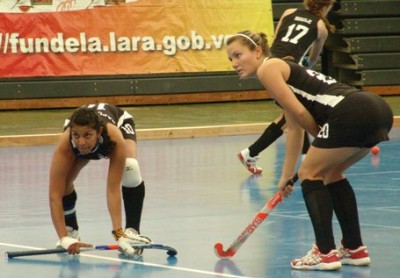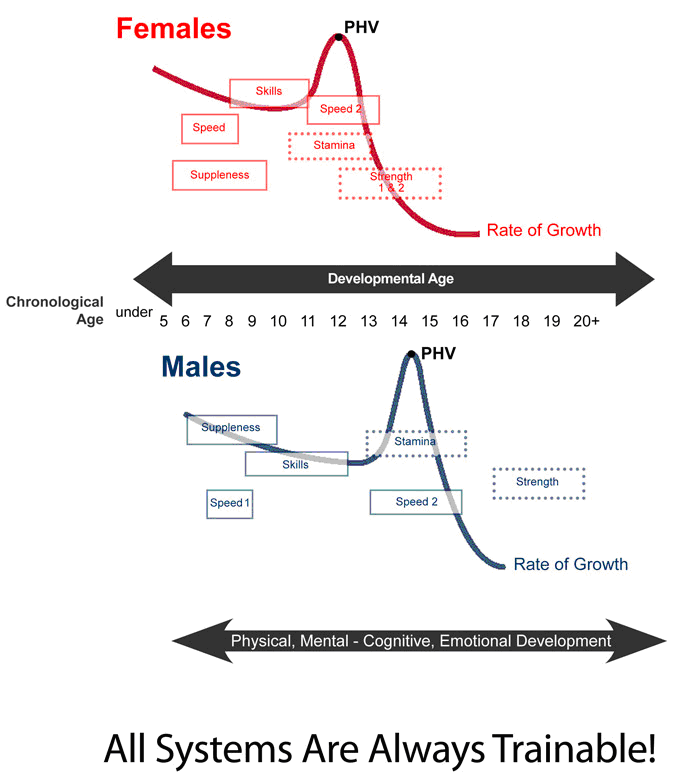
The LTHD model is built on the following research, principles and tools.
1. The 10-year Rule
Scientific research has determined that it takes at least 10 years and 10,000 hours of training for athletes in any sport to reach elite performance levels. While the LTHD model promotes basic physical wellness for a broad range of field hockey participants regardless of ability or disability, it has also been designed to address the long-term needs of players who pursue excellence for World Cup or Olympic performance according to the 10-year rule.
2. The FUNdamentals
All sports are based on fundamental movement skills and sports skills. Basic movement skills include agility, balance, and coordination, while basic sports skills include running, jumping, throwing, kicking, catching, and dribbling. Research has demonstrated that children will achieve excellence in a broad variety of sports if they are trained to be physically “literate” in these basic skills prior to their adolescent growth spurt, and they will also be more likely to find satisfaction in lifelong physical activity.
3. Specialization
Some sports require “early specialization” to obtain elite performance levels, such as gymnastics and figure skating, while other sports demonstrate better athlete performance through “late specialization,” such as team sports. As a late specialization sport, field hockey relies on a variety of components in the overall sport system (schools, recreation centres, other sports) to develop physical literacy during the FUNdamental stage, as well as speed and suppleness training into adolescence. LTHD actively discourages early specialization in field hockey (e.g. prior to the age of 10 years) since premature specialization contributes to imbalanced physical development, overuse injuries, early burnout, and inadequate development of movement and sports skills.
4. Developmental Age
Everyone passes through the same stages of development from early childhood through adolescence, but the timing, rate, and amount of their development varies. This is described as the difference between chronological age and developmental age. Two children may be the same chronological age (e.g. 11 years old), but at the same time they may be four to five years apart in developmental age. LTHD asks field hockey coaches and administrators to take developmental age into account when they design programs and select players.
5. Trainability
The physiological systems of every player can be trained at any age, but there are critical periods in the player’s development when the body is especially responsive to specific types of movement and skills training. To reach their genetic potential, players need to receive the right type of training at the correct stage of development. If these critical periods are missed, players may grow to be fast, jump high, and strike well, but they will never be as fast, jump as high, or strike as well as they might have done with timely specialized training.

6. Physical, Mental, Cognitive, and Emotional Development
As players grow from childhood through adolescence, they experience significant changes in physical, mental, cognitive, and emotional development. Coaches and administrators need to consider these changes carefully when they plan training programs and design competition formats. Failure to address these changes may result in mental or emotional burnout, undue mental stress, anxiety, diminished confidence, and early exit from the sport.
7. Periodization
Periodization refers to the time frames that are used to schedule player training, competition, and recovery. Field hockey programs at every stage of player development need to follow a logical and scientific schedule to ensure that players remain healthy and achieve optimum performance at the required time. Periodization plans are adjusted at each stage of development to account for player growth, maturation, and trainability.
8. Calendar Planning for Competition
The calendar for game competition has a critical impact on the development of each player. Different stages of development have different requirements for the type, frequency, and level of competition. At certain stages, training physical capacities in players is more beneficial to their long-term performance and wellness than formal match competition. Put simply, short-term competitive success should not be emphasized for children and youth players at the expense of their long-term development. If players are to reach levels of excellence and remain active for life, training-to-competition ratios at each stage of development must be sensitive to their long term needs.
9. System Alignment and Integration
LTHD recognizes that long-term player development is influenced by a number of different elements and groups in the overall field hockey and sports system, such as club teams, physical education programs, recreational activities, school programs, and provincial associations. To optimize athlete development, LTHD asks that these different groups and institutions become integrated and aligned with each other, ensuring that they are mutually supportive, clear in their roles and responsibilities, and aware of how they contribute to player learning and development. Players will best develop in a coordinated field hockey system that is clearly defined, logically structured, and based upon consistent principles. Through LTHD, players are able to identify the opportunities available to them and to understand the pathway they need to follow, whether their aim is long-term excellence or simply remaining active for life.
10. Continuous Improvement
LTHD is based on the best available research in sports science and the best practices in player development around the world, but knowledge and research continue to grow. LTHD should respond to new scientific research and field hockey-specific innovations to ensure that the development system continually optimizes the systematic and logical delivery of programs, and LTHD may even initiate new research. As well, LTHD should drive ongoing education, promotion, and advocacy regarding player development with government, media, educators, parents, coaches, administrators, and sports scientists.

